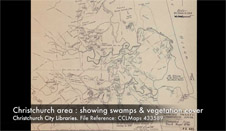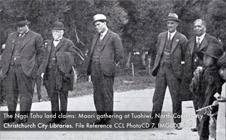 As you explore the New Zealand Garden, take note of the swamp-like area in the eastern part of the garden. Doesn't it seem odd that there should be a swamp in the middle of a city? A map of Christchurch in 1850, known as the Black Map, shows the types of terrain that existed here when the Deans Brothers arrived and when Kemp made his purchase, and the extent to which early settlers have altered the landscape over time. Where we now see paved streets and green grass was once murky swamp and expanses of tussock.
As you explore the New Zealand Garden, take note of the swamp-like area in the eastern part of the garden. Doesn't it seem odd that there should be a swamp in the middle of a city? A map of Christchurch in 1850, known as the Black Map, shows the types of terrain that existed here when the Deans Brothers arrived and when Kemp made his purchase, and the extent to which early settlers have altered the landscape over time. Where we now see paved streets and green grass was once murky swamp and expanses of tussock.
Very few Ngāi Tūāhuriri made homes in this area in 1848 because of the difficulties of living in that sort of environment. What we now know as central Christchurch was an area for hunting and gathering food to take back to established communities, such as those of Tuahiwi, Kaiapoi and Rapaki.
The original, pre-colonial landscape was a major reason for the disruption the Christchurch Earthquakes caused. Being built on swamp land, it was prone to movement, and the liquefaction that was forced up through the ground was an untimely reminder of the origin of this land. But where buildings tumbled and liquefaction rose, people dusted themselves off and embarked on a long journey of rebuilding and recovering, showing enormous strength of spirit and love for the place they call home.
Following the confiscation of this area of land by the crown, the area between Harper Avenue and Carlton Mill Road – known as Little Hagley Park – was occupied by 150 Ngāi Tūāhuriri and Ngāi Tahu Māori in 1868, while they fought for compensation from the Land Court. These claims were unsuccessful, but only hardened the resolve of the people of Ngāi Tahu and Ngāi Tūāhuriri, generations of whom have since fought for over 150 years for justice, and fair compensation for their losses.
 The Government has over time negotiated specific settlements with Ngāi Tahu in response to the past injustices of the Kemp purchase. The compensation has only been recent, and did not align with the economic, physical, emotional and spiritual impacts of this purchase on generations of Ngāi Tahu descendants. However Ngāi Tahu and Ngāi Tūāhuriri have used this settlement and the autonomy and self-determination to retain their mana as individuals, as hapu, and as an iwi.
The Government has over time negotiated specific settlements with Ngāi Tahu in response to the past injustices of the Kemp purchase. The compensation has only been recent, and did not align with the economic, physical, emotional and spiritual impacts of this purchase on generations of Ngāi Tahu descendants. However Ngāi Tahu and Ngāi Tūāhuriri have used this settlement and the autonomy and self-determination to retain their mana as individuals, as hapu, and as an iwi.
The rebuilding and recovering for the iwi continues, just as it does for the city of Christchurch, and the resilience shown by both are inspiring.
